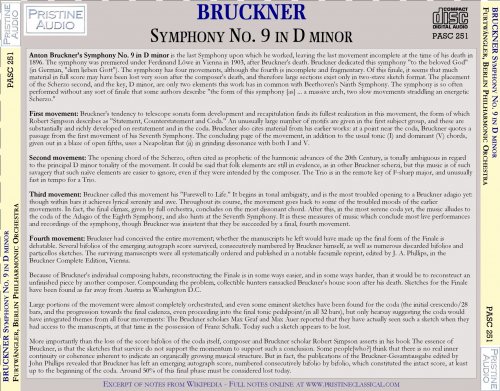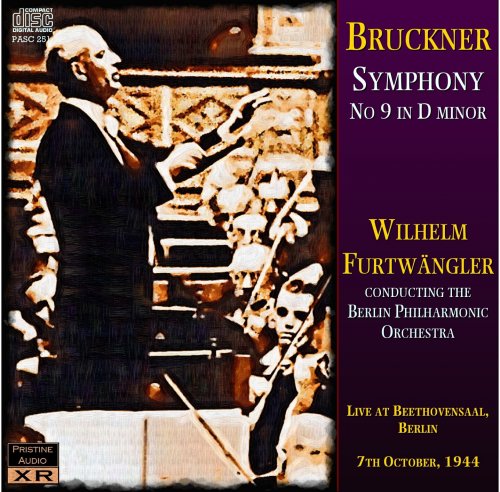
Berliner Philharmoniker, Wilhelm Furtwangler - Bruckner: Symphony No. 9 (2010)
BAND/ARTIST: Berliner Philharmoniker, Wilhelm Furtwangler
- Title: Bruckner: Symphony No. 9
- Year Of Release: 2010
- Label: Pristine
- Genre: Classical
- Quality: FLAC (tracks)
- Total Time: 59'01''
- Total Size: 191 MB
- WebSite: Album Preview
Tracklist:
[01] I. Feierlich. Misterioso
[02] II. Scherzo. Bewegt, lebhaft - Trio. Schnell
[03] III. Adagio. Langsam, feierlich

[01] I. Feierlich. Misterioso
[02] II. Scherzo. Bewegt, lebhaft - Trio. Schnell
[03] III. Adagio. Langsam, feierlich
But even these extraordinary achievements pale beside the miracle of the 1944 Bruckner Symphony # 9...
Furtwängler once said that "an interpreter can render only what he has first lived through." Of all the conductors who have grappled with the complex challenges of the Bruckner Ninth, Furtwängler was best positioned to understand what Bruckner had achieved. Bruno Walter had hinted at this when he observed that he never understood Bruckner until he became mortally ill. The Ninth is not a failed attempt at a cohesive artistic statement. Rather, it is a complete and perfect musical depiction of a tortured mind: a desperate snatch at a vision that grew ever more elusive, a vain quest for understanding and fulfillment in a world that would not provide it, a fevered groping for fragments of life in the lengthening shadow of death. As he wrestled with his Ninth Symphony, Bruckner stood at the very edge of that abyss. By late 1944, Furtwängler stood there too.
The first climax of the first movement heralds his emotion. The Berlin Philharmonic is fully controlled and its ensemble perfectly together, and yet the tempo is so unstable and dynamically alive that no note falls quite where its predecessors would suggest, as if to reflect the entire orchestra's heaving, nervous desperation. Furtwängler often spent entire rehearsals polishing crucial transitions, but not here; he chops the first movement into dozens of inconclusive fragments, deliberately wrenching the mood from lilting lyricism to raw savagery, the tempos from standstill to runaway, and dynamics from inaudible to heavily overloaded. The movement ends in screaming trumpets, a primordial burst of sheer abject terror as both Bruckner and Furtwängler confronted the most horrifying fear of all: that at the very end of their struggles there would be only a void.
Although nothing could eclipse the unparalleled power of the opening, the wonders of this radical reworking of the Bruckner Ninth do not end with the shattering climax of the first movement. Furtwängler whips the scherzo and trio from a slightly menacing waltz and bucolic pastorale into a furiously driven, vertiginous ride to damnation. He then gradually builds the unintended adagio finale to a terrifying dissonance, after which the exhausted fragments wither into eternal silence.
None of this is explicit in the score. It took Furtwängler to recognize and recreate an absolutely perfect depiction of a single mind and, by extension, an entire world on the brink of collapse."
Furtwängler once said that "an interpreter can render only what he has first lived through." Of all the conductors who have grappled with the complex challenges of the Bruckner Ninth, Furtwängler was best positioned to understand what Bruckner had achieved. Bruno Walter had hinted at this when he observed that he never understood Bruckner until he became mortally ill. The Ninth is not a failed attempt at a cohesive artistic statement. Rather, it is a complete and perfect musical depiction of a tortured mind: a desperate snatch at a vision that grew ever more elusive, a vain quest for understanding and fulfillment in a world that would not provide it, a fevered groping for fragments of life in the lengthening shadow of death. As he wrestled with his Ninth Symphony, Bruckner stood at the very edge of that abyss. By late 1944, Furtwängler stood there too.
The first climax of the first movement heralds his emotion. The Berlin Philharmonic is fully controlled and its ensemble perfectly together, and yet the tempo is so unstable and dynamically alive that no note falls quite where its predecessors would suggest, as if to reflect the entire orchestra's heaving, nervous desperation. Furtwängler often spent entire rehearsals polishing crucial transitions, but not here; he chops the first movement into dozens of inconclusive fragments, deliberately wrenching the mood from lilting lyricism to raw savagery, the tempos from standstill to runaway, and dynamics from inaudible to heavily overloaded. The movement ends in screaming trumpets, a primordial burst of sheer abject terror as both Bruckner and Furtwängler confronted the most horrifying fear of all: that at the very end of their struggles there would be only a void.
Although nothing could eclipse the unparalleled power of the opening, the wonders of this radical reworking of the Bruckner Ninth do not end with the shattering climax of the first movement. Furtwängler whips the scherzo and trio from a slightly menacing waltz and bucolic pastorale into a furiously driven, vertiginous ride to damnation. He then gradually builds the unintended adagio finale to a terrifying dissonance, after which the exhausted fragments wither into eternal silence.
None of this is explicit in the score. It took Furtwängler to recognize and recreate an absolutely perfect depiction of a single mind and, by extension, an entire world on the brink of collapse."

Download Link Isra.Cloud
Berliner Philharmoniker, Wilhelm Furtwangler - Bruckner: Symphony No. 9 (2010)-
My blog
Berliner Philharmoniker, Wilhelm Furtwangler - Bruckner: Symphony No. 9 (2010)-
My blog
As a ISRA.CLOUD's PREMIUM member you will have the following benefits:
- Unlimited high speed downloads
- Download directly without waiting time
- Unlimited parallel downloads
- Support for download accelerators
- No advertising
- Resume broken downloads


